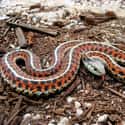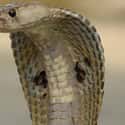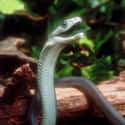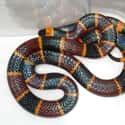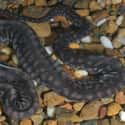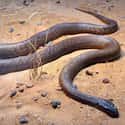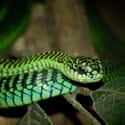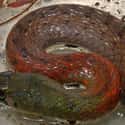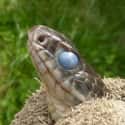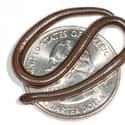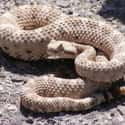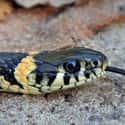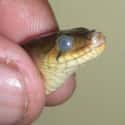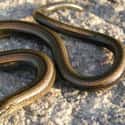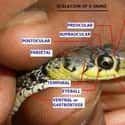-
(#1) Snake Hearts Move Around In Their Bodies
Snakes lack diaphragms, which means the heart's position in the body can adjust somewhat. This usually happens so that the heart doesn't get damaged when the the snake is ingesting large prey. They can literally make room for dessert!
-
(#2) It's Venomous Snakes, Not Poisonous Snakes
The technical difference between poison and venom is that poison is inhaled or ingested whereas venom is injected. Venomous snakes like vipers and cobras inject their prey with venom through their fangs.
-
(#3) The Black Mamba Is The Most Dangerous Snake In The World
Kill Bill got this one dead right. Black mambas may not technically be the most venomous snakes in the world but they are widely considered the most dangerous. They're very fast as far as snakes go and can lift up to a third of their body off the ground in defensive stances. They're extremely territorial and can deliver multiple envenoming bites in a single strike, in rapid succession.
-
(#4) A Snake's Paired Organs Are Arranged In A Line
Humans have their paired organs - kidneys, lungs, and gonads - aligned side by side in their body. Due to the elongated body of a snake, their paired organs are arranged one in front of the other.
-
(#5) The Titanoboa Is The Largest Snake That Has Ever Lived
This extinct species of snake lived about 60 million years ago. The picture above is a model exhibited at the Smithsonian, but fossilized vertebrate comparisons led paleontologists to believe these snakes could reach lengths up to 42 feet and weigh as much as 2,500 pounds!
-
(#6) Most Snakes Have Only One Lung
One functioning lung for respiration, that is. In most snakes the left lung is vestigial, meaning it's still present in the body but no longer serving any physiological function. In other words evolution is still phasing it out, like the human appendix. Some aquatic snakes do still use their vestigial left lung for buoyancy, however.
-
(#7) The Inland Taipan Is The Most Venomous Snake In The World
Commonly called the fierce snake, these are found in the arid regions of central Australia. Snake venom toxicity is measured by median lethal dose, written as LD50. In testing on rats, the LD50 for inland taipan venom is .000025 grams per kilogram of body mass. To put that in perspective, the amount of venom an inland taipan can deliver in a single bit is potent enough to kill 100 adult human males.
-
(#8) Rainbow Boas Were Once Popular Pets
The rainbow boa, or Epicrates cenchria, was a popular type of domesticated snake in the '80s and '90s. They are native to Central and South America and require a specific humidity and heat to thrive. They are especially prized for their structural coloration that results in naturally iridescent skin.
-
(#9) Boomslangs Really Exist
This is a picture of boomslang. Yes, that is the real name of a real snake in the family Colubridae. Boomslang literally means "tree snake" in Afrikaans and Dutch. Perhaps the name makes them so memorable since boomslangs are referenced in popular titles like Team Fortress and Harry Potter. Boomslangs are able to open their jaws up to 170 degrees when biting.
-
(#10) There Are Two Technically Poisonous Snakes
The Rhabdophis genus of snakes found in Southeast Asia and they are actually poisonous due to the toxins they sequester from toads they eat. These snakes can then secrete these poisons to ward off predators. Oregon garter snakes also retain enough poisons in their liver from the newts they eat to be toxic to would-be predators like crows or foxes.
-
(#11) Snakes Are Polyphyodonts
Polyphyodonts are animals that continually replace their teeth throughout their lives. Snakes are included in this classification. Non-venomous snakes have rows of replaceable teeth and no fangs.
-
(#12) Where CAN'T Snakes Be Found?
Snakes can be found just about anywhere, save for the Arctic Circle and Antarctica. But you might be surprised that some of the major islands they also can't be found in Iceland, Ireland, and New Zealand.
-
(#13) This Snake Can Fit On A Quarter
The smallest known living species of snake is the Barbados threadsnake, found on the island that is its namesake. This little critter only grows to about 10 centimeters and is so small it doesn't have the conventional teeth of most snakes. It is believed that they feed on termites and ant larvae.
-
(#14) What Is Up With That Rattle?
The venomous rattlesnakes found in North America all have this distinctive tail feature. The rattle is made of a series of hollow, interlocked segments of keratin that vibrate when the snake contracts its tail muscles. The most widely accepted explanation for this feature and behavior is that it's meant to be a warning sign for predators.
-
(#15) The Deadliest Snakes In The World Are The 'Big Four'
The Big Four are a group of venomous snakes all native to the Indian Subcontinent that result in the greatest number of snake bites and induced fatalities in the region. They are the Russell's viper (pictured above), the Indian cobra, the saw-scaled viper, and the common krait. Conservative estimates hold that 81,000 envenomings and 11,000 induced deaths occur in India every year from these snakes collectively, making for the highest rate of snake bites and deaths in the world as well.
-
(#16) Snakes Have A 'Jacobson's Organ'
Snakes are visually distinctive for their forked tongues, which let them both smell and taste the air. The tongue collects particles from the air and then presses them up to the Jacobson's organ which analyzes the particles to direct the snake towards prey. The organ lies at the base of the nasal cavity.
-
(#17) Snakes Do Not Have Eyelids
Instead, they have scales. Unlike the scales that cover the rest of their bodies, the scales over their eyes are transparent optic scales called brille. Brille molts off snakes just like the rest of their skin. You can tell because the brille will get cloudy as it gets ready to be shed.
-
(#18) The Caduceus And The Rod Of Asclepius
These two symbols of antiquity involving snakes and staffs are commonly confused. The Caduceus is a rod surmounted with wings and two snakes entwined around it, carried by the Greek god Hermes, and meant to be a symbol of trade and commerce, although it's also mistakenly used as a symbol of medicine. People confuse it with the Rod of Asclepius. Asclepius was the actual ancient Greek God of medicine and his staff only had one snake entwined around it, with no cap wings.
-
(#19) Voldemort's Snake Wasn't Randomly Named Nagini
In Buddhism and Hinduism there are types of deities that take the form of king cobras called nāgas. Their cultural significance varies between different regions and traditions, but some of the things they're commonly associated with are virility and natural disasters. Female nāgas are called "nāgini."
-
(#20) Digestion Is A Big Commitment
For snake species that feed only sporadically, they go into serious a food coma when digesting a big meal. Some snakes even increase their body temperature by as much as 2.2 degrees Fahrenheit due to their highly increased metabolisms.
-
(#21) Snakes vs. Legless Lizards
There are a few characteristics that distinguish snakes from other orders of legless lizards. Snakes lack eyelids and external ear openings. Also, other kinds of legless lizards have long tails and short bodies compared to snakes who have long bodies but short tails. The critter in the picture above is a kind of legless lizard called a slow worm.
-
(#22) Snake Skins Are Used To Make Huqin Instruments
The huqin family of instruments is made up of traditional Chinese string instruments with one or two strings attached between a round sound box and long, thin neck. The sound boxes of these kinds of instruments have traditionally been covered with snake skin, most often of pythons.
-
(#23) The Vast Terminology Of Snake Head Scales
There's an extensive vocabulary to describe the scales that cover a snake's head. They're mostly named for their positioning relative to the other features of a snake head. These include the preocular, presubocular and postocular scales around the eye for example.
-
(#24) Are Snakes Related To Burrowing Lizards Or Aquatic Mosasaurs?
There are two major theories regarding the evolutionary origins of snakes. The first is that snakes are related to burrowing varanids or monitor lizards. The second is that snakes are related to extinct aquatic mosasaurs that lived in the late Cretaceous period.
-
(#25) Could You Eat A Live Snake?
If you were Lebanese commando, you might have to! Apparently there's an annual ceremony wherein Lebanese commandos gather for demonstrations of strength, including eating a live snake with their bare hands. The Daily Mail even got photos of the challenge at a security convention in Beirut in 2015. Fair warning, it ain't pretty.
New Random Displays Display All By Ranking
About This Tool
With regard to mysterious snakes, people from all over the world have created many myths and legends. Since ancient times, snakes have been worshiped and deified in many areas, symbolized power, wisdom, and renewal, people are afraid of these cold reptiles. There are more than 3,000 species of snakes on the blue planet, and about 1,000 of them are poisonous.
Snakes are one of the scariest animals on the planet, some of which are born with two heads, some can reproduce asexually. The random tool will tell you 25 unusual and interesting facts about snakes that you may not know before.
Our data comes from Ranker, If you want to participate in the ranking of items displayed on this page, please click here.











